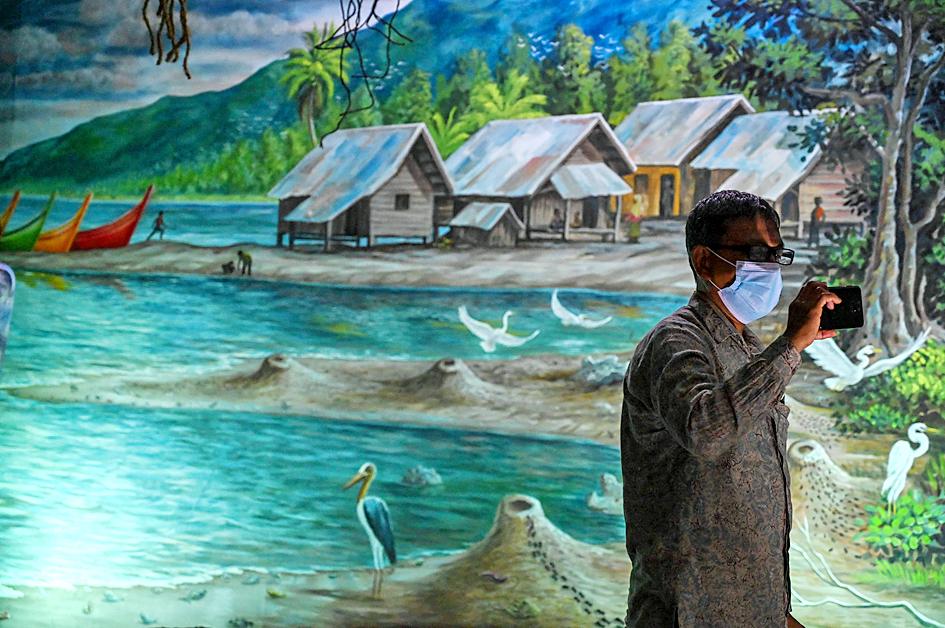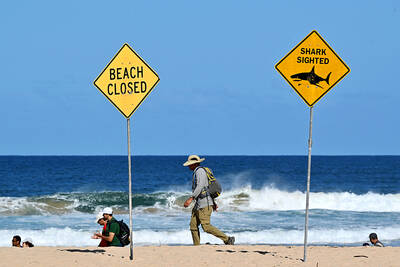A tsunami could soon hit major cities on or near the Mediterranean Sea including Marseille, Alexandria and Istanbul, with a nearly 100 percent chance of a wave reaching more than a meter high in the next 30 years, UNESCO said.
The risk of a tsunami in Mediterranean coastal communities is predicted to soar as sea levels rise.
While communities in the Pacific and Indian Ocean, where most tsunamis occur, were often aware of the dangers, it was underestimated in other coastal regions, including the Mediterranean, UNESCO said.

Photo: AFP
The UN organization said that five at-risk communities in the Mediterranean would join 40 other “tsunami-ready” towns and cities in 21 countries by next year. As well as Marseille, Alexandria and Istanbul, they include Cannes and Chipiona, a town on Spain’s Atlantic coast near Cadiz.
The “tsunami-ready” program is part of UNESCO’S broader effort, launched ahead of the UN Ocean Conference in Lisbon next week, to ensure that all at-risk communities know what to do in the event of a tsunami by 2030.
“The tsunamis of 2004 and 2011 were a wake-up call,” UNESCO lead tsunami expert Bernardo Aliaga said. “We have come a long way since 2004. We are safer today, but there are gaps in preparedness and we need to improve; we need to make sure warnings are understood by visitors and communities.”
The Indian Ocean tsunami on Boxing Day in 2004, the deadliest in history, killed an estimated 230,000 people in 14 countries, while the magnitude 9.1 earthquake and tsunami in 2011, which reached nearly 40m in height, killed 18,000 people in Japan.
Since the 2004 tsunami, UNESCO’s Pacific Tsunami Warning Center, hosted by the US, has responded to 125 tsunami events, averaging seven a year.
“The upstream part is in good shape” Aliaga said. “Work has been done to establish 12 tsunami-warning centers covering most of the ocean, including the Mediterranean.”
The warning centers include five in the Mediterranean and northeast Atlantic, including Greece, Turkey, Italy, France and Portugal.
“The risk of tsunami is underestimated in most areas, including the Mediterranean,” Aliaga said. “Events are not very frequent and the risk does not translate from one generation to another.”
“We need to get the message out,” he added. “In the Mediterranean, there is no question about it: It is not if, it’s when.”
One of the deadliest earthquakes in history hit Portugal on All Saints’ Day in 1755, generating a tsunami 6m high in Lisbon and Cadiz. Up to 50,000 people died in the earthquake, but many unsuspecting others perished in the ensuing fires and tsunami.
Tsunamis just 1.5m to 2m high can lift vehicles off the ground, while smaller waves can result in walls of water traveling at 65kph.
“The warning is not the full story,” Aliaga said. “The second part is community preparedness — how people behave and react. That has a way to go.”
He cited the case of Tilly Smith, a 10-year-old British girl who led 100 people, including her family, to safety in the 2004 tsunami. She had been told by her geography teacher at school to evacuate immediately on seeing receding water.
Sea-level rises, which increase the impact of tsunamis on coastal communities, are “one more reason to increase the pace of our work,” he said.
“The link is that sea-level rise increases the impact of tsunamis,” he added.
Authorities in Alexandria, Istanbul, Marseille, Cannes and Chipiona are working on “tsunami-ready” preparedness, including evacuation signs and procedures, as well as plans for warning tourists, he said.
“We want 100 percent of communities, where there is a proven hazard, to be ready to respond by 2030,” he said. “They will have evacuation maps, they will have carried out exercises and they will already have in place 24-hour alerts.”
Alerts were triggered about 10 minutes after an earthquake hit, he said, and could take the form of anything from bullhorns to WhatsApp messages.
“If it’s a local tsunami, you have 20 minutes maximum before the first wave hits. The second wave is larger and comes 40 minutes after the first one. You still have the possibility of escape,” he said.

With much pomp and circumstance, Cairo is today to inaugurate the long-awaited Grand Egyptian Museum (GEM), widely presented as the crowning jewel on authorities’ efforts to overhaul the country’s vital tourism industry. With a panoramic view of the Giza pyramids plateau, the museum houses thousands of artifacts spanning more than 5,000 years of Egyptian antiquity at a whopping cost of more than US$1 billion. More than two decades in the making, the ultra-modern museum anticipates 5 million visitors annually, with never-before-seen relics on display. In the run-up to the grand opening, Egyptian media and official statements have hailed the “historic moment,” describing the

SECRETIVE SECT: Tetsuya Yamagami was said to have held a grudge against the Unification Church for bankrupting his family after his mother donated about ¥100m The gunman accused of killing former Japanese prime minister Shinzo Abe yesterday pleaded guilty, three years after the assassination in broad daylight shocked the world. The slaying forced a reckoning in a nation with little experience of gun violence, and ignited scrutiny of alleged ties between prominent conservative lawmakers and a secretive sect, the Unification Church. “Everything is true,” Tetsuya Yamagami said at a court in the western city of Nara, admitting to murdering the nation’s longest-serving leader in July 2022. The 45-year-old was led into the room by four security officials. When the judge asked him to state his name, Yamagami, who

‘CHILD PORNOGRAPHY’: The doll on Shein’s Web site measure about 80cm in height, and it was holding a teddy bear in a photo published by a daily newspaper France’s anti-fraud unit on Saturday said it had reported Asian e-commerce giant Shein (希音) for selling what it described as “sex dolls with a childlike appearance.” The French Directorate General for Competition, Consumer Affairs and Fraud Control (DGCCRF) said in a statement that the “description and categorization” of the items on Shein’s Web site “make it difficult to doubt the child pornography nature of the content.” Shortly after the statement, Shein announced that the dolls in question had been withdrawn from its platform and that it had launched an internal inquiry. On its Web site, Le Parisien daily published a

DEADLY PREDATORS: In New South Wales, smart drumlines — anchored buoys with baited hooks — send an alert when a shark bites, allowing the sharks to be tagged High above Sydney’s beaches, drones seek one of the world’s deadliest predators, scanning for the flick of a tail, the swish of a fin or a shadow slipping through the swell. Australia’s oceans are teeming with sharks, with great whites topping the list of species that might fatally chomp a human. Undeterred, Australians flock to the sea in huge numbers — with a survey last year showing that nearly two-thirds of the population made a total of 650 million coastal visits in a single year. Many beach lovers accept the risks. When a shark killed surfer Mercury Psillakis off a northern Sydney beach last